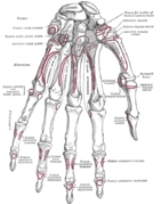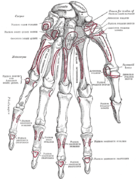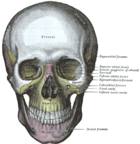
Gray's Anatomy
Encyclopedia

English language
English is a West Germanic language that arose in the Anglo-Saxon kingdoms of England and spread into what was to become south-east Scotland under the influence of the Anglian medieval kingdom of Northumbria...
human anatomy
Human anatomy
Human anatomy is primarily the scientific study of the morphology of the human body. Anatomy is subdivided into gross anatomy and microscopic anatomy. Gross anatomy is the study of anatomical structures that can be seen by the naked eye...
textbook
Textbook
A textbook or coursebook is a manual of instruction in any branch of study. Textbooks are produced according to the demands of educational institutions...
originally written by Henry Gray
Henry Gray
Henry Gray was an English anatomist and surgeon most notable for publishing the book Gray's Anatomy. He was elected a Fellow of the Royal Society at the age of 25.-Biography:...
. The book is widely regarded as an extremely influential work on the subject, and has continued to be revised and republished from its initial publication in 1858 to the present day. The first edition of the book was called Anatomy: Descriptive and Surgical, but its name is commonly shortened to, and later editions are titled, Gray's Anatomy.
After publication in the United Kingdom
United Kingdom
The United Kingdom of Great Britain and Northern IrelandIn the United Kingdom and Dependencies, other languages have been officially recognised as legitimate autochthonous languages under the European Charter for Regional or Minority Languages...
in 1858, the book was also released in the United States the following year. Gray released a second edition in the UK in 1860, but died shortly after its publication, at the age of 34, having contracted smallpox
Smallpox
Smallpox was an infectious disease unique to humans, caused by either of two virus variants, Variola major and Variola minor. The disease is also known by the Latin names Variola or Variola vera, which is a derivative of the Latin varius, meaning "spotted", or varus, meaning "pimple"...
while treating his nephew (who survived). Work on his much-praised book has continued by others to the present day. On 26 September 2008, the 40th British edition of the book was published together with an accompanying website.
Origins

Henry Gray
Henry Gray was an English anatomist and surgeon most notable for publishing the book Gray's Anatomy. He was elected a Fellow of the Royal Society at the age of 25.-Biography:...
was born in 1827. He studied the development of the endocrine glands and spleen
Spleen
The spleen is an organ found in virtually all vertebrate animals with important roles in regard to red blood cells and the immune system. In humans, it is located in the left upper quadrant of the abdomen. It removes old red blood cells and holds a reserve of blood in case of hemorrhagic shock...
and in 1853 was appointed Lecturer on Anatomy at St George's Hospital Medical School in London. In 1855 he approached his colleague Henry Vandyke Carter
Henry Vandyke Carter
Henry Vandyke Carter was an English anatomist, surgeon, and anatomical artist most notable for his illustrations of the book, Gray's Anatomy.-Biography:...
with his idea to produce an inexpensive and accessible anatomy textbook for medical students. Dissecting unclaimed bodies from workhouse and hospital mortuaries through the Anatomy Act of 1832, the two worked for 18 months on what would form the basis of the book. Gray's death came just three years after the publication of his Anatomy Descriptive and Surgical. The first two editions were published in England by J.W. Parker, in 1858 and 1860. An edition of the English publication was published in the United States in 1859. Longman's publication reportedly began in 1863, after acquiring the J.W. Parker publishing business. This coincides with the publishing date of the third English edition of Gray's Anatomy.
American editions
The American rights were purchased by Blanchard and Lea, who published the first U.S., or "American Editions" of Gray's Anatomy on June 18 1908. Lea & Febiger continued publishing the American editions until the company was sold in 1990.The First American publication was edited by Richard James Dunglison, whose father Robley Dunglison
Robley Dunglison
Robley Dunglison was an English physician who moved to America to join the first faculty of the University of Virginia. He was personal physician to Thomas Jefferson and considered the "Father of American Physiology".-Biography:...
was physician to Thomas Jefferson
Thomas Jefferson
Thomas Jefferson was the principal author of the United States Declaration of Independence and the Statute of Virginia for Religious Freedom , the third President of the United States and founder of the University of Virginia...
. Dunglison edited the next four editions. These were: the Second American Edition (February 1862); the New Third American from the Fifth English Edition (May 1870); the New American from the Eighth English Edition (July 1878); and the New American from the Tenth English Edition (August 1883). Dr W.W. Keen
William Williams Keen
William Williams Keen was the first brain surgeon in the United States. He also saw Franklin Delano Roosevelt when his paralytic illness struck, and worked closely with six American presidents.-Biography:...
edited the next two editions, namely: the New American from the Eleventh English Edition (Sept. 1887); and the New American from the Thirteenth English Edition (Sept. 1893).
In September 1896 reference to the English edition was dropped, and it was published as the Fourteenth Edition, edited by Bern B. Gallaudet, F.J. Brockway, and J.P. McMurrich, who also edited the Fifteenth Edition (Oct. 1901). The Sixteenth Edition (October 1905) was edited by J.C. DaCosta, and the Seventeenth (Sept. 1908) by DaCosta and E.A. Spitzka
Edward Anthony Spitzka
Edward Anthony Spitzka was an American anatomist who autopsied the brain of Leon Czolgosz, the assassin of president William McKinley. Edward Anthony Spitzka (June 17, 1876 – September 4, 1922) was an American anatomist who autopsied (29 Oct 1901) the brain of Leon Czolgosz, the assassin of...
. Spitzka edited the Eighteenth (Oct. 1910) and Nineteenth (July 1913) editions, and in October 1913, R. Howden edited the New American from the Eighteenth English Edition. The "American" editions then continued with consecutive numbering from the Twentieth onwards, with W.H. Lewis editing the 20th (Sept. 1918), 21st (Aug. 1924), 22nd (Aug. 1930), 23rd (July 1936), and 24th (May 1942). C.M. Gross edited the 25th (Aug. 1948), 26th (July 1954), 27th (Aug. 1959), 28th (Aug. 1966), and 29th (Jan. 1973). Carmine D. Clemente edited and extensively revised the 30th edition (October 1984). With the sale of Lea & Febiger in 1990, the 30th edition was the last American Edition.
Discrepancies in numbering of American and British editions
The mismatch between British and American edition numbering led to the existence, for many years, of two main "flavors" or "branches" of Gray's Anatomy: the U.S. and the British one. This can easily cause misunderstandings and confusion, especially when quoting from or trying to purchase a certain edition. For example a comparison of publishing histories shows that the American numbering kept roughly apace with the British up until the 16th editions in 1905, with the American editions either acknowledging the English edition, or simply matching the numbering in the 14th, 15th and 16th editions. Then the American numbering crept ahead, with the 17th American edition published in 1908, while the 17th British edition was published in 1909. This increased to a three-year gap for the 18th and 19th editions, leading to the 1913 publication of the New American from the Eighteenth English, which brought the numbering back into line. Both 20th editions were then published in the same year (1918). Thereafter, it was the British numbering that published ahead, with the 21st British edition in 1920, and the 21st American edition in 1924. This discrepancy continued to increase, so that the 30th British edition was published in 1949, while the 30th and last American edition was published in 1984.Most recent available editions

Elsevier
Elsevier is a publishing company which publishes medical and scientific literature. It is a part of the Reed Elsevier group. Based in Amsterdam, the company has operations in the United Kingdom, USA and elsewhere....
under the Churchill Livingstone
Churchill Livingstone
Churchill Livingstone is an imprint of a medical publishing company owned by Elsevier Ltd, but previously owned by Harcourt and Pearson. It was formed in 1971 from the merger of E & S Livingstone, Edinburgh, Scotland, and J & A Churchill, London, England. It is but now integrated with the rest of...
imprint in both print and on-line versions.
Companion publications such as Gray's Anatomy for Students
Gray's Anatomy for Students
Gray's Anatomy for Students is an anatomy textbook inspired by the famous Gray's Anatomy and aimed primarily at medical students. The text has been praised for its innovative illustration style, which emphasizes clarity and a conceptual approach to learning.While carrying the Gray name and covering...
written by Richard L. Drake, Wayne Vogl and Adam W. M. Mitchell. Gray's Atlas of Anatomy (and package versions containing both), and Gray's Anatomy Review have also been published.
Older editions of the book continue to be reprinted and sold. On the World Wide Web
World Wide Web
The World Wide Web is a system of interlinked hypertext documents accessed via the Internet...
, there are many offers for what seem to be reprint
Reprint
A reprint is a re-publishing of material that has already been previously published. The word reprint is used in many fields.-Academic publishing:...
s of the 1901 (probably U.S.) edition. Although such prints may serve artistic uses because their companion illustrations and anatomical cross sections
Cross section (geometry)
In geometry, a cross-section is the intersection of a figure in 2-dimensional space with a line, or of a body in 3-dimensional space with a plane, etc...
are renowned for their rustic and often haunting presentation, they no longer represent up-to-date anatomical understanding, as much less was known at the time.
Henry Gray wrote the original version of Gray's Anatomy with an audience of medical student
Medical Student
Medical Student may refer to:*Someone studying at medical school*Medical Student Newspaper, a UK publication...
s and physician
Physician
A physician is a health care provider who practices the profession of medicine, which is concerned with promoting, maintaining or restoring human health through the study, diagnosis, and treatment of disease, injury and other physical and mental impairments...
s in mind, especially surgeon
Surgery
Surgery is an ancient medical specialty that uses operative manual and instrumental techniques on a patient to investigate and/or treat a pathological condition such as disease or injury, or to help improve bodily function or appearance.An act of performing surgery may be called a surgical...
s. For many decades however, precisely because Gray's textbook became such a classic, successive editors made major efforts to preserve its position as possibly the most authoritative text on the subject in the English language
English language
English is a West Germanic language that arose in the Anglo-Saxon kingdoms of England and spread into what was to become south-east Scotland under the influence of the Anglian medieval kingdom of Northumbria...
. Toward this end, a long-term strategy appears to have been to have the book contain a fully comprehensive account of the anatomical and medical understanding available at the time of publication of each edition. Given the explosion of medical understanding in the 20th century, it is easily appreciated that this led to a vast expansion of the book, which threatened to collapse under its own weight in a metaphor
Metaphor
A metaphor is a literary figure of speech that uses an image, story or tangible thing to represent a less tangible thing or some intangible quality or idea; e.g., "Her eyes were glistening jewels." Metaphor may also be used for any rhetorical figures of speech that achieve their effects via...
ical and physical sense. From the 35th edition onward, increased efforts were made to reverse this trend and keep the book readable by students. Nevertheless, the 38th edition contained 2,092 pages in large format.
Newer editions of Gray's Anatomy (and even several older ones) are still considered to be about the most comprehensive and detailed books of such type on the subject.
The senior editor of the latest, 40th, edition of Gray's Anatomy book and accompanying website is Professor Susan Standring, who is Emeritus Professor of Anatomy at King's College London
King's College London
King's College London is a public research university located in London, United Kingdom and a constituent college of the federal University of London. King's has a claim to being the third oldest university in England, having been founded by King George IV and the Duke of Wellington in 1829, and...
.
Cultural references
The AmericanUnited States
The United States of America is a federal constitutional republic comprising fifty states and a federal district...
medical drama
Medical drama
A medical drama is a television program, in which events center upon a hospital, an ambulance staff, or any medical environment.In the United States, most medical episodes are one hour long and, more often than not, are set in a hospital. Most current medical Dramatic programming go beyond the...
Grey's Anatomy
Grey's Anatomy
Grey's Anatomy is an American medical drama television series created by Shonda Rhimes. The series premiered on March 27, 2005 on ABC; since then, seven seasons have aired. The series follows the lives of interns, residents and their mentors in the fictional Seattle Grace Mercy West Hospital in...
takes its name from the title of this book. The 1996 Steven Soderbergh film Gray's Anatomy, featuring monologuist Spalding Gray
Spalding Gray
Spalding Rockwell Gray was an American actor, playwright, screenwriter, performance artist and monologuist...
, also takes its name from the title of the book, as does Gray's Anatomy: Selected Writings, a 2009 book by British political philosopher John N. Gray.
In Atonement
Atonement (novel)
Atonement is a 2001 novel by British author Ian McEwan.On a fateful day, a young girl makes a terrible mistake that has life-changing effects for many people...
, the work is studied at great length by the character Robbie Turner.
See also
Further reading
- Gray's Anatomy: The Anatomical Basis of Clinical Practice, 40th edition (2008), 1576 pages, Churchill-Livingstone, Elsevier. ISBN 978-0-443-06684-9
- Richardson, Ruth. The Making of Mr. Gray's Anatomy, (2008). Oxford University PressOxford University PressOxford University Press is the largest university press in the world. It is a department of the University of Oxford and is governed by a group of 15 academics appointed by the Vice-Chancellor known as the Delegates of the Press. They are headed by the Secretary to the Delegates, who serves as...
. ISBN 0199552991 - Hayes, Bill. The Anatomist: a True story of Gray's Anatomy, (2007). Ballantine. ISBN 978-0345456892
External links
- Online version of Gray's Anatomy — The complete 20th U.S. edition of Gray's Anatomy of the Human Body, published in 1918.
- First American publication of the English edition (Philadelphia, 1859). Note: This is not the 'American' edition. American rights had yet to be purchased. See article text
- Online audio recording of the text of the same edition of Gray's Anatomy in five parts: 12345
- Video of @Google Talk by Bill Hayes on Gray's Anatomy
- iPhone version of one of the early editions of Gray's Anatomy, with illustrations of Henry Vandyke Carter.

